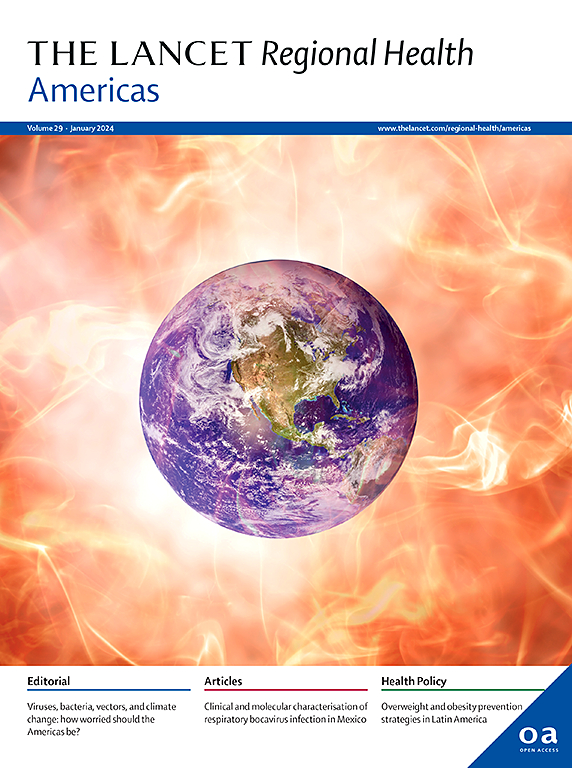早期慢性恰加斯心肌病患者外周血转录组的免疫学变化:一项横断面研究
IF 7
Q1 HEALTH CARE SCIENCES & SERVICES
引用次数: 0
摘要
恰加斯病是由原生动物寄生虫克氏锥虫引起的,是一种被忽视的疾病,全世界约有600万人受到影响。在感染者中,20-30%会发展为慢性恰加斯心肌病(CCC),许多人最终会发展为晚期心力衰竭。这种进展发生的机制尚不清楚。在这项探索性研究中,我们试图提供与早期CCC发展相关的生理变化的见解。方法采用RNA测序方法分析6例伴有早期结构性心脏病的恰加斯病患者、4例无疾病体征或症状的恰加斯病患者、13例无早期结构性心脏病的恰加斯病患者和10例无恰加斯病或心脏病体征的恰加斯病患者外周血基因表达变化。通路分析和免疫细胞反褶积被用来进一步阐明早期CCC发展的生物学过程。研究结果表明,早期CCC与各种外周免疫反应基因的下调有关,包括抗原呈递减少和T细胞活化的变化。值得注意的是,这些基因和过程似乎与非恰加斯心肌病不同。这项工作强调了免疫应答在早期CCC中的潜在重要性,为这种疾病的早期发病机制以及它与其他心肌病的不同之处提供了见解。我们发现的这些变化可以作为早期CCC的生物标志物,并可以为未来的疾病进展标志物和早期CCC治疗策略的纵向队列研究提供信息。资助nih, FONDECYT, IDSA, NSF。本文章由计算机程序翻译,如有差异,请以英文原文为准。
Immunologic changes in the peripheral blood transcriptome of individuals with early-stage chronic Chagas cardiomyopathy: a cross-sectional study
Background
Chagas disease, caused by the protozoan parasite Trypanosoma cruzi, is a neglected disease that affects approximately 6 million individuals worldwide. Of those infected, 20–30% will go on to develop chronic Chagas cardiomyopathy (CCC), and many ultimately to advanced heart failure. The mechanisms by which this progression occurs are poorly understood. In this exploratory study, we sought to provide insight into the physiologic changes associated with the development of early CCC.
Methods
We used RNA sequencing to analyse the gene expression changes in the peripheral blood of six patients with Chagas disease with early structural heart disease, four patients with Chagas disease without any signs or symptoms of disease, thirteen patients without Chagas disease with early structural heart disease, and ten patients without Chagas disease or signs of heart disease. Pathway analyses and immune cell deconvolution were employed to further elucidate the biological processes underlying early CCC development.
Findings
Our analysis suggests that early CCC is associated with a downregulation of various peripheral immune response genes, including changes suggestive of reduced antigen presentation and T cell activation. Notably, these genes and processes appear to be distinct from those of non-Chagas cardiomyopathies.
Interpretation
This work highlights the potential importance of the immune response in early CCC, providing insight into the early pathogenesis of this disease and how it may differ from other cardiomyopathies. The changes we have identified may serve as biomarkers of early CCC and could inform future longitudinal cohort studies of markers of disease progression and strategies for the treatment of CCC in its early stages.
Funding
NIH, FONDECYT, IDSA, NSF.
求助全文
通过发布文献求助,成功后即可免费获取论文全文。
去求助
来源期刊

Lancet Regional Health-Americas
Multiple-
CiteScore
8.00
自引率
0.00%
发文量
0
期刊介绍:
The Lancet Regional Health – Americas, an open-access journal, contributes to The Lancet's global initiative by focusing on health-care quality and access in the Americas. It aims to advance clinical practice and health policy in the region, promoting better health outcomes. The journal publishes high-quality original research advocating change or shedding light on clinical practice and health policy. It welcomes submissions on various regional health topics, including infectious diseases, non-communicable diseases, child and adolescent health, maternal and reproductive health, emergency care, health policy, and health equity.
 求助内容:
求助内容: 应助结果提醒方式:
应助结果提醒方式:


